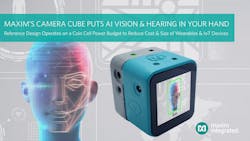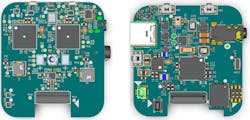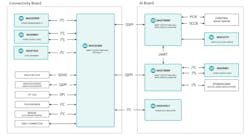Tiny AI Cube Recognizes Audio Commands and Camera Images
Check out more Kit Close-Up videos.
In this video, I take a look at Maxim Integrated's AI cube camera, the MAXREFDES178 (Fig. 1). It packs an amazing amount of computing power in a tiny package, which is great for developers looking to take advantage of the company's MAX78000 system-on-chip (SoC).
The MAX78000 has a Cortex-M4F core, but the artificial-intelligence (AI) work is normally done by the convolutional-neural-network (CNN) accelerator with a 332k 8-bit weight capability. It supports 1-, 2- 4-, and 8-bit weights with a programmable input image size up to 1024 × 1024 pixels. And it handles one- and two-dimensional convolutions with up to 64 layers. The cube has a built-in microphone in addition to input jacks, allowing it to process voice commands.
Inside, the system consists of two boards plus a battery (Fig. 2). The connectivity board includes a MAX32666 microcontroller with Bluetooth 5 support. A matching set of apps for Android and Apple smartphones can be used to configure the systems as well as download trained models to the built-in applications. These applications work right out of the box, but you can add more images to be recognized using the app without any further software modifications.
The two boards are connected by a ribbon cable (Fig. 3) that has QSPI and I2C interfaces. The dual-core MAX32666 manages wireless communication as well as the USB interface. A debug module plugs into the USB Type-C socket so that program changes can be made. AMicroSD card slot also can be used for software and data. In addition, the micro handles the touchscreen and the BMI160 accelerometer and gyro.
The video MAX78000 takes input directly from the Omnivision Technologies OVM7692 camera armed with 640 × 480 resolution. It also can control the two LEDs directly. The other MAX78000 handles audio input from a digital MEMS microphone (SPH0645LM4H) on the front panel. The MAX34417 is an SMBus four-channel, high-dynamic-range accumulator with a multiplexed ADC. It can be used to track the power utilization of the MAX78000 chips.
The MAX78000 chips can work with multiple machine-learning (ML) models. They're powerful enough to support real-time image recognition, such as face identification along with voice analysis. The demos include voice-command recognition and image recognition of faces and animals.
All software and schematics are available as well. The software development kit (SDK) works with Mac, Windows, and Linux.
Overall, this is a reference kit with lots of potential. The demos highlight the capabilities of the system and there's plenty to test simply by adjusting the recognition models. The training is done in the cloud, although the models are strictly for the demonstration programs. Training models for a specific application will take a bit more work.
Check out more Kit Close-Up videos.
Links
- Maxim Integrated (now part of Analog Devices)
- MAXREFDES178
- MAX32666
About the Author
William G. Wong
Senior Content Director - Electronic Design and Microwaves & RF
I am Editor of Electronic Design focusing on embedded, software, and systems. As Senior Content Director, I also manage Microwaves & RF and I work with a great team of editors to provide engineers, programmers, developers and technical managers with interesting and useful articles and videos on a regular basis. Check out our free newsletters to see the latest content.
You can send press releases for new products for possible coverage on the website. I am also interested in receiving contributed articles for publishing on our website. Use our template and send to me along with a signed release form.
Check out my blog, AltEmbedded on Electronic Design, as well as his latest articles on this site that are listed below.
You can visit my social media via these links:
- AltEmbedded on Electronic Design
- Bill Wong on Facebook
- @AltEmbedded on Twitter
- Bill Wong on LinkedIn
I earned a Bachelor of Electrical Engineering at the Georgia Institute of Technology and a Masters in Computer Science from Rutgers University. I still do a bit of programming using everything from C and C++ to Rust and Ada/SPARK. I do a bit of PHP programming for Drupal websites. I have posted a few Drupal modules.
I still get a hand on software and electronic hardware. Some of this can be found on our Kit Close-Up video series. You can also see me on many of our TechXchange Talk videos. I am interested in a range of projects from robotics to artificial intelligence.



